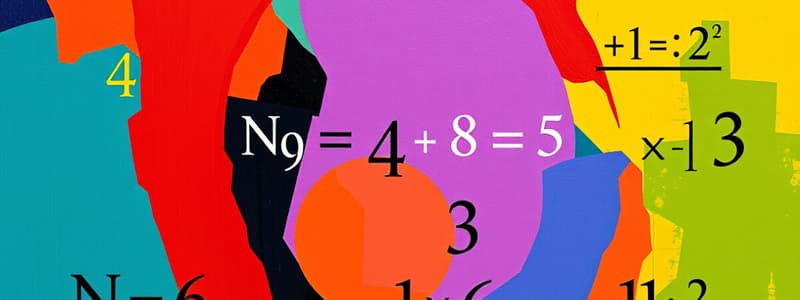Podcast
Questions and Answers
Which expression would be negative? (Select all that apply)
Which expression would be negative? (Select all that apply)
- 3 - 6 (correct)
- (-3) / 3 (correct)
- (-3) / 3 (correct)
- (-6) / 3 (correct)
- 6 - 3
Division and multiplication are inverse operations.
Division and multiplication are inverse operations.
True (A)
Find the length and midpoint of a segment whose endpoints have coordinates -5 and 12.
Find the length and midpoint of a segment whose endpoints have coordinates -5 and 12.
Length: 17, Midpoint: 3.5
Simplify -15 + (-8)(-4).
Simplify -15 + (-8)(-4).
The answer to (-27)(-54)(15) is negative.
The answer to (-27)(-54)(15) is negative.
The expression a - b is called a(n) __________.
The expression a - b is called a(n) __________.
Any number being multiplied in a product is called a(n) __________.
Any number being multiplied in a product is called a(n) __________.
Before fractions can be added, they must have a common __________.
Before fractions can be added, they must have a common __________.
Write (-5) as repeated factors, then evaluate.
Write (-5) as repeated factors, then evaluate.
Multiply -5 and -8.
Multiply -5 and -8.
The absolute value of -5 is 5.
The absolute value of -5 is 5.
Simplify 4^(-2).
Simplify 4^(-2).
Add -17 + 3.
Add -17 + 3.
The opposite of 57 is 57.
The opposite of 57 is 57.
Divide -90 by -6.
Divide -90 by -6.
The number 7 is both natural and rational.
The number 7 is both natural and rational.
Add 4.2 + (-5.1) - (-2).
Add 4.2 + (-5.1) - (-2).
Flashcards are hidden until you start studying
Study Notes
Test Overview
- Chapter 1 covers fundamental concepts in mathematics, including expressions, operations, and properties of numbers.
- The test consists of multiple-choice, simplification, evaluation, and reasoning questions.
Key Concepts and Terminology
- Negative Expression: A negative expression includes numbers less than zero, e.g., (-6).
- Rational Numbers: Numbers that can be expressed as the quotient of two integers, e.g., (\pi) and (-3.5) are irrational.
- Inverse Operations: Division and multiplication are inverses; they undo each other's effects.
Operations and Simplifications
- Length and Midpoint: To find the length and midpoint between two coordinates, use the formula for distance and the average.
- Power Expression: Repeated multiplication can be expressed as a power (e.g., (3^n)).
- Simplifying Expressions: Perform operations in the correct order, following the rules of arithmetic (PEMDAS/BODMAS).
Fractions and Common Terms
- Common Denominator: Necessary for adding fractions to ensure their denominators are the same.
- Terms in an Expression: Important terms include addend, factor, minuend, subtrahend, and sum.
Sets and Number Properties
- Set Intersection and Union: Intersection (common elements) and union (all elements) of sets R and S are significant concepts.
- Absolute Values: The absolute value of a number is its distance from zero, ignoring sign.
Arithmetic with Negative Numbers
- Addition and Subtraction: Understand how to add and subtract negative numbers.
- Evaluating Expressions: Be able to compute the results of various operations systematically.
Special Properties and Rules
- Opposite Values: The opposite of a number changes its sign (e.g., opposite of (-26) is (26)).
- Simplifying Complex Expressions: Break down expressions with multiple operations into simpler parts to evaluate correctly.
Financial Literacy Application
- Checkbook Management: Track deposits, withdrawals, and interest to find the ending balance.
- Real-World Mathematics: Applications of number operations in personal finance illustrate practical use.
Calculation Techniques
- Order of Operations: Always follow the correct order (parentheses, exponents, multiplication and division from left to right, addition and subtraction from left to right).
- Dividing Negative Numbers: The division of two negative numbers results in a positive number.
These study notes highlight critical mathematical principles and problem-solving strategies essential for mastering the content in Chapter 1.
Studying That Suits You
Use AI to generate personalized quizzes and flashcards to suit your learning preferences.




